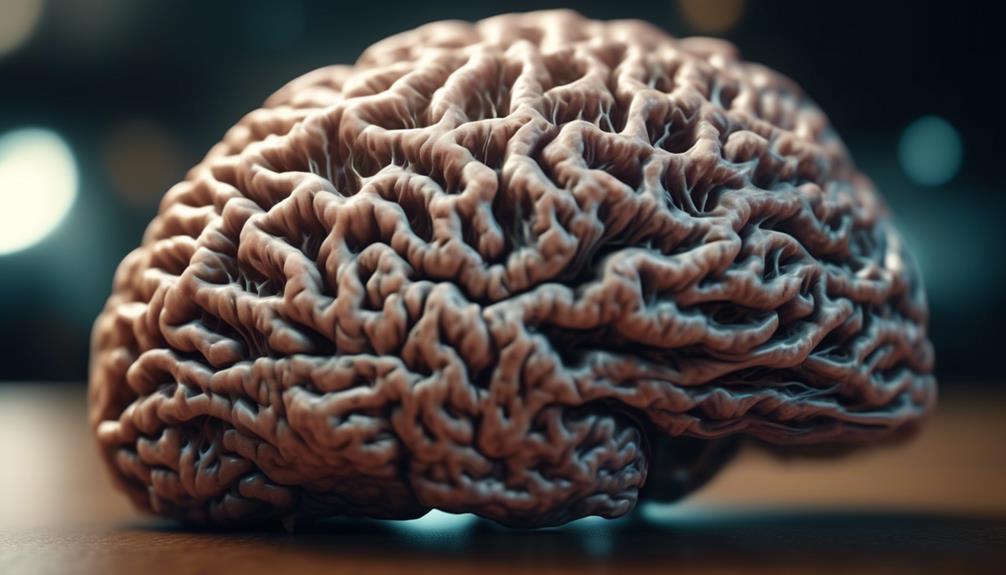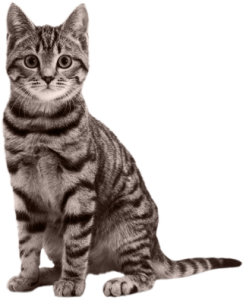Cats have long been known for their mysterious and enigmatic nature, often leaving us in awe of their intelligence and cunning behaviors. Many pet owners can attest to their cat's ability to problem-solve and navigate complex situations with apparent ease.
But what is it about their brain anatomy that sets them apart? As we delve into the intricate structures and functions of the feline brain, a fascinating world of neurological prowess and evolutionary adaptations is unveiled.
From the cerebral cortex to the olfactory bulb, each component plays a crucial role in shaping the remarkable intelligence of these captivating creatures.
Key Takeaways
- Cats' cognitive prowess has been shaped by their evolutionary history and specialized traits.
- The cerebral cortex, particularly in areas associated with sensory perception, spatial reasoning, and memory, is responsible for higher cognitive functions in cats.
- Neurotransmitters and synapses play a crucial role in cats' learning, memory, and overall cognitive performance.
- The amygdala and cerebellum are important brain regions that contribute to cats' emotional processing, social dynamics, motor skills, spatial navigation, and sensory perception.
Evolutionary History
The evolutionary history of cats can be traced back millions of years, revealing a fascinating lineage of adaptation and diversification within the Felidae family. Through natural selection, cats have developed an array of specialized traits that have conferred upon them an evolutionary advantage. One such advantage is their exceptional cognitive development, which has enabled them to thrive in various environments.
The Felidae family's evolutionary journey has honed cats' physical and cognitive abilities to ensure their survival. Their keen senses, agility, and predatory skills have been finely tuned through millennia of evolution, allowing them to effectively navigate and thrive in diverse ecosystems. These evolutionary adaptations have contributed to their success as efficient hunters and adept survivors.
Furthermore, the cognitive development of cats has been integral to their evolutionary advantage. Their ability to problem-solve, adapt to new situations, and exhibit complex social behaviors has undoubtedly contributed to their widespread distribution and ecological success. From the efficient solitary hunters to the highly social lions, the cognitive prowess of cats has been a driving force behind their ability to conquer a multitude of habitats and ecological niches.
Cerebral Cortex
Having established the evolutionary underpinnings of cats' cognitive prowess, a comprehensive examination of their brain structure reveals the intricate complexities of the cerebral cortex and its role in shaping feline behavior and cognitive abilities.
The cerebral cortex, also known as the neocortex, is the outermost layer of the brain and is responsible for higher cognitive functions. In cats, it plays a crucial role in their problem-solving skills and adaptive behaviors.
The cerebral cortex is divided into different regions, each with specific functions related to sensory perception, motor control, and higher cognitive processes. In cats, the cerebral cortex is highly developed, particularly in areas associated with sensory perception, spatial reasoning, and memory. This extensive development allows cats to process complex information from their environment, strategize during hunting activities, and exhibit remarkable problem-solving abilities.
Furthermore, the cerebral cortex's intricate neural networks enable cats to exhibit advanced cognitive skills, such as learning, memory retention, and decision-making. This complex structure contributes to the feline's ability to adapt to various environments, make informed choices, and exhibit a wide range of behaviors that showcase their intelligence and problem-solving capabilities.
Neurotransmitters and Synapses
In the intricate network of the feline brain, neurotransmitters and synapses form the fundamental communication system that underlies the intricate processes of cognitive function and behavior. Neurotransmitters are essential for neuronal communication, and their efficiency plays a crucial role in determining the overall cognitive abilities of cats. These chemical messengers transmit signals across synapses, which are the junctions between neurons. The efficiency of neurotransmission is vital for the proper functioning of the brain, as it directly impacts learning, memory, and overall cognitive performance in cats.
Furthermore, synaptic plasticity, the ability of synapses to strengthen or weaken over time in response to increases or decreases in their activity, is a key factor in shaping the feline brain's adaptability and learning capacity. This plasticity allows the brain to reorganize its structure, forming new neural connections and pathways in response to experiences and environmental changes.
Understanding the intricate interplay between neurotransmitter efficiency and synaptic plasticity provides valuable insights into the remarkable cognitive abilities of cats, shedding light on their intelligence and adaptive behavior.
Amygdala and Emotions
Unveiling the intricate networks of the feline brain, the amygdala, a critical component of the limbic system, governs the processing of emotions and emotional responses in cats. This almond-shaped cluster of nuclei plays a pivotal role in emotional regulation and fear conditioning.
The amygdala receives sensory information from the thalamus, allowing it to evaluate the emotional significance of stimuli. It processes fear-inducing stimuli, leading to fear conditioning, where associations between a neutral stimulus and fear are formed. Additionally, the amygdala modulates emotional responses by integrating input from various brain regions and regulating the release of neurotransmitters.
Studies have shown that the amygdala's size and neuronal density correlate with the complexity of social behaviors and the ability to recognize emotions in others. Furthermore, its interactions with the prefrontal cortex and hippocampus contribute to the cat's ability to navigate social dynamics and form emotional memories.
Understanding the amygdala's role in emotional processing provides valuable insights into feline behavior and cognition, aiding in the development of effective strategies for enhancing their emotional well-being.
Cerebellum and Motor Skills
The cerebellum, a highly organized structure located at the base of the brain, plays a crucial role in coordinating and refining the motor skills and movements of cats. This intricate part of the feline brain is essential for the smooth execution of movements, balance, and posture.
The cerebellum is involved in the integration of sensory perception, motor planning, and motor learning. It receives input from the sensory systems, the spinal cord, and other parts of the brain to regulate motor function. Motor development in cats heavily relies on the cerebellum's ability to process and integrate sensory information to fine-tune movements.
Furthermore, the cerebellum is also implicated in cognitive processing related to motor skills, such as spatial navigation and motor coordination. Its involvement in these processes showcases the significant impact of the cerebellum on not only basic motor functions but also higher-order cognitive abilities.
Understanding the role of the cerebellum in motor skills is crucial for comprehending the exceptional agility and coordination exhibited by cats.
Olfactory Bulb and Scent Processing
The refinement of sensory perception extends beyond motor skills in cats, as the olfactory bulb, a critical component of their brain, governs the intricate processing of scents and odors.
Cats possess a highly developed olfactory system, with approximately 200 million olfactory receptors in their nasal cavity, compared to about 5-20 million in humans. This abundance of receptors enables cats to discriminate between a wide range of scents, allowing them to distinguish between different prey, predators, and potential mates.
The olfactory bulb also plays a crucial role in memory formation, as it is interconnected with brain areas associated with emotion and memory. This connectivity allows cats to form strong associations between specific scents and past experiences, aiding in their ability to navigate their environment and interact with other animals.
Furthermore, the olfactory system in cats demonstrates remarkable brain plasticity, allowing for adaptation to new scents and environments. Understanding the complexities of the feline olfactory system provides valuable insights for various fields, including animal behavior, veterinary medicine, and scent-based technologies.
Hippocampus and Memory
Located within the feline brain, the hippocampus is a vital structure associated with the encoding, consolidation, and retrieval of memories. Memory consolidation, the process of stabilizing a memory trace after initial acquisition, is a key function of the hippocampus. This consolidation process involves the transfer of information from short-term to long-term memory, thereby enabling the retention of learned experiences and knowledge.
The hippocampus also plays a crucial role in spatial navigation, which is particularly significant in the lives of cats. This region of the brain allows cats to form cognitive maps of their environment, facilitating their ability to navigate and remember spatial layouts. Studies have shown that damage to the hippocampus can greatly impair a cat's spatial memory and navigational skills, highlighting the essential role of this brain structure in their daily activities.
Understanding the hippocampus and its involvement in memory processes is important for providing optimal care and enrichment for cats. By recognizing the significance of memory consolidation and spatial navigation in feline behavior, pet owners and caregivers can create environments that support and stimulate their cognitive abilities, ultimately enhancing their overall well-being.
Comparative Brain Size
Comparing brain sizes across different species reveals intriguing insights into the neurological evolution of mammals. In the context of brain development and cognitive abilities, the comparative brain size of different mammalian species is a crucial factor. The evolution of brain size in mammals has been linked to their cognitive abilities and adaptation to their environments. Larger brains, relative to body size, have been associated with higher cognitive abilities and more complex social behaviors in various mammalian species. For instance, species with larger brains often exhibit a greater capacity for problem-solving, innovation, and learning.
In the case of cats, their brain size relative to their body mass is considered to be relatively large compared to other mammals. This larger brain size is thought to contribute to their exceptional sensory perception, learning capabilities, and adaptability.
Furthermore, the comparative analysis of brain size between different species provides valuable insights into the evolutionary mechanisms that have shaped the cognitive abilities of mammals. Understanding the relationship between brain size and cognitive abilities across species can offer significant contributions to the field of neuroscience and evolutionary biology.
Frequently Asked Questions
How Do Cats' Brains Compare to Other Animals in Terms of Problem-Solving Abilities?
Cats exhibit impressive problem-solving abilities, attributed to their unique brain structure, cognitive development, genetic factors, and environmental impact. Training techniques, breed differences, and socialization effects further influence their problem-solving skills, making them adaptable and intelligent creatures.
Are There Specific Genetic Factors That Contribute to Cats' Intelligence?
Genetic factors play a crucial role in cats' intelligence, influencing their cognitive development. Studies suggest that specific genes related to brain function and problem-solving abilities contribute to the intelligence observed in these animals, shedding light on their exceptional cognitive capabilities.
Can Cats Be Trained to Improve Their Cognitive Abilities?
Cognitive training for cats involves utilizing feline behavior and problem-solving techniques to enhance brain plasticity. Genetic predisposition and breed intelligence, coupled with socialization impact and environmental enrichment, contribute to the potential for improvement in cats' cognitive abilities.
Do Different Cat Breeds Have Varying Levels of Intelligence?
Cognitive differences in feline intelligence are influenced by breed characteristics. Various cat breeds exhibit varying levels of intelligence, evidenced through problem-solving abilities, trainability, and social interactions. Understanding these breed-specific traits assists in optimizing training and enrichment strategies.
How Do Environmental Factors, Such as Socialization and Enrichment, Impact a Cat's Brain Development and Intelligence?
Environmental factors, such as socialization and enrichment, play a crucial role in a cat's brain development and intelligence. Socialization fosters cognitive abilities, while enrichment activities stimulate neural connections, contributing to enhanced intelligence and adaptive behaviors.


